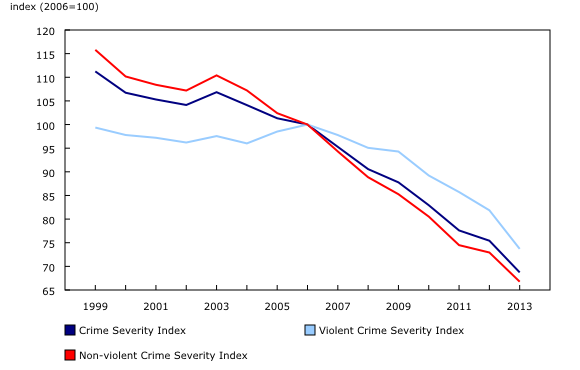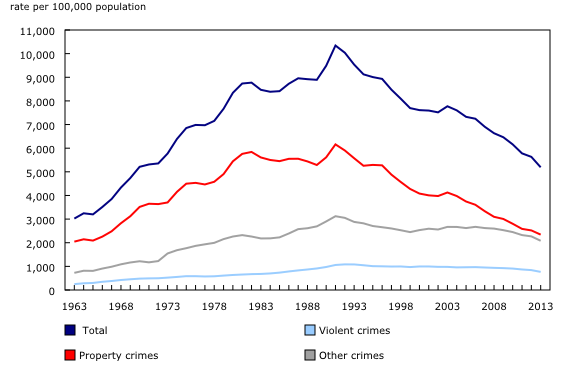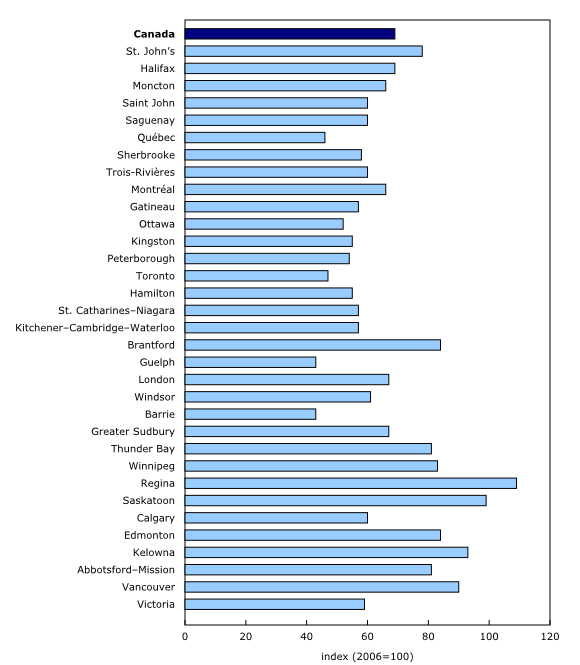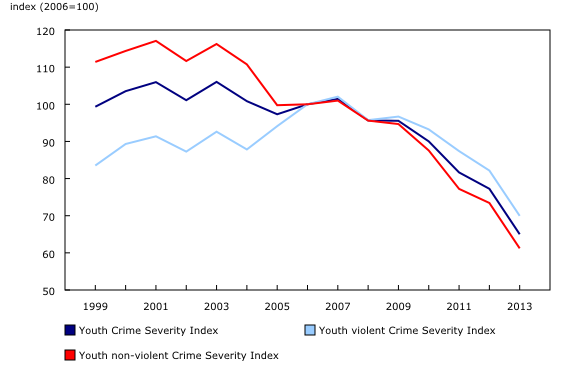Police-reported crime statistics, 2013
Archived Content
Information identified as archived is provided for reference, research or recordkeeping purposes. It is not subject to the Government of Canada Web Standards and has not been altered or updated since it was archived. Please "contact us" to request a format other than those available.
Released: 2014-07-23
The police-reported Crime Severity Index (CSI), which measures the volume and severity of crime, declined 9% in 2013 compared with 2012. This was the 10th consecutive decline in the index. The CSI was 36% lower than 10 years earlier.
The traditional crime rate also declined in 2013 compared with 2012, falling 8%. It continued its long-term downward trend that began in the early 1990s, reaching its lowest level since 1969. Since 1962, the traditional crime rate has measured the volume of crime, but does not take into account the severity of crimes.
Canadian police services reported just over 1.8 million criminal incidents (Criminal Code offences excluding traffic) in 2013, down approximately 132,000 from the previous year.
Most offences were down in 2013. The decline in the CSI was specifically attributable to declines in breaking and entering and robbery. Decreases in some of the less serious but very frequent offences, such as theft of $5,000 or under and mischief, also contributed to the drop in the CSI.
However, some offences were up in 2013. In particular, police services reported more incidents of extortion, child pornography, aggravated sexual assault (level 3), sexual violations against children and identity fraud.
Crime Severity Index down in most provinces and territories
In 2013, most provinces and territories recorded a decrease in their CSI compared with 2012. However, the CSI increased in Yukon (+6%) and Newfoundland and Labrador (+1%).
Prince Edward Island, New Brunswick, Quebec and Manitoba (-12% each) recorded the largest declines among the provinces and territories.
In most provinces, the decline in the CSI was largely due to fewer breaking and entering incidents. However, in British Columbia, robberies were behind the decline in the CSI. In the Northwest Territories, a decrease in homicides resulted in the drop in the CSI, whereas the decline in Nunavut was due to a large decrease in incidents of mischief.
As in previous years, each territory had a higher CSI than any province. Saskatchewan had the highest CSI among the provinces, while Ontario had the lowest.
Crime Severity Index down in almost all census metropolitan areas
For the first time since 1998, the first year for which the CSI was calculated, none of Canada's census metropolitan areas (CMAs) recorded an increase in its CSI. The CSI was unchanged in Edmonton, while it declined in all other CMAs. The largest decrease compared with 2012 was in Victoria (-17%).
Despite a 7% drop in its CSI, Regina had the highest CSI of any CMA, while Barrie and Guelph had the lowest.
Violent Crime Severity Index continues to decline
The violent CSI fell 10% in 2013 compared with 2012, marking the seventh consecutive decrease.
Canadian police services reported approximately 384,000 violent incidents in 2013, down about 32,000 from the previous year. The decline in the violent CSI was mainly due to a decrease in robberies and, to a lesser extent, fewer assaults with a weapon or causing bodily harm (level 2), common assaults (level 1) and uttering threats.
Police reported 505 homicides in 2013, down 38 from 2012. The homicide rate was 1.44 victims per 100,000 population, the lowest rate since 1966. Police also reported 642 attempted murders in 2013, down 23 from the previous year.
Every province and territory except Newfoundland and Labrador saw a decrease in their violent CSI compared with 2012. Similarly, every CMA saw their violent CSI decline except Trois-Rivières, St. John's, Brantford and Calgary, which recorded increases.
Increase in police-reported "sexual violations against children"
In 2013, the police reported 4,232 incidents in the "sexual violations against children" category, 279 more than in 2012. This was one of the only violent crime categories to increase in 2013.
The "sexual violations against children" category includes five specific offences under the Criminal Code: luring a child via a computer, sexual exploitation, sexual interference, invitation to sexual touching and making sexually explicit material available to a child. However, this category excludes sexual assaults against children, which are classified with all other sexual assaults, including those against adults.
Of the sexual violations against children, luring a child via a computer showed the greatest increase, rising 30% in 2013, followed by sexual exploitation (+11%). In contrast, invitation to sexual touching decreased 5%.
Non-violent Crime Severity Index is down
Most crimes reported by the police are non-violent. Police reported just over 1.4 million non-violent incidents in 2013, or nearly four crimes in five, of which 1.1 million were property crimes. The non-violent CSI decreased 8% compared with 2012, the 10th consecutive decrease in this index. The non-violent CSI was 40% lower than a decade earlier.
While most non-violent offences declined in 2013, the decrease in the non-violent CSI was mainly due to a large drop in the number of incidents of breaking and entering, theft of $5,000 or under and mischief. However, some offences in the non-violent category rose in 2013, specifically counterfeiting, child pornography and identity fraud.
Almost every province and territory saw their non-violent CSI decline in 2013. The largest decreases were in New Brunswick and Prince Edward Island, while the non-violent CSI was stable in Newfoundland and Labrador and increased in Yukon.
Most CMAs also saw a decrease in their non-violent CSI except Edmonton, where the index rose in 2013 as a result of more motor vehicle thefts and theft of $5,000 or under.
The youth Crime Severity Index down for the fourth consecutive year
The youth CSI fell by 16% in 2013 compared with 2012, the fourth consecutive decline. The youth CSI measures the volume and severity of crimes for which an accused aged 12 to 17 was identified.
The decline in the youth CSI was mainly due to fewer youths accused of robbery, breaking and entering or theft of $5,000 or under.
Every province and territory except Yukon saw their youth CSI decline compared with 2012. Among the provinces, Saskatchewan recorded the highest youth CSI, while British Columbia, Ontario and Quebec had the lowest.
Note to readers
The crime rate and the Crime Severity Index (CSI) are complementary measures of police-reported crime. The crime rate measures the volume of crime reported to the police per 100,000 population, while the CSI measures both the volume and severity of crimes.
To calculate the CSI, each offence is assigned a weight based on the average sentence handed down by criminal courts for this offence. The more serious the average sentence, the higher the weight for that offence. To calculate the CSI, the weighted offences are summed and then divided by the population. As with other indexes, to simplify comparison, the CSI is then standardized to a base year of "100" (for the CSI, the base year is 2006). In other words, all CSI values are relative to the Canada-level CSI for 2006. CSI values are available back to 1998.
In addition to the overall CSI, a violent CSI and a non-violent CSI were created. Like the overall CSI, they have been standardized; therefore, the values for these indexes are relative to the Canada-level indexes for the base year, namely "100" for 2006. For more information on the concepts and use of the severity indexes, see the document Measuring Crime in Canada: Introducing the Crime Severity Index and Improvements to the Uniform Crime Reporting Survey (Catalogue number85-004-X), accessible on our website in the Publications module, under the Browse by key resource tab.
Data are drawn from the Uniform Crime Reporting Survey, a census of all crime known to, and substantiated by, police services. However, for incidents of child pornography, due to the complexity of these incidents, the data likely reflect the number of active or closed investigations for the year rather than the total number of incidents reported to police. These crime statistics conform to a nationally approved set of common crime categories and definitions. They have been systematically reported by police services and submitted to Statistics Canada every year since 1962. Differences in local police service policies, procedures and enforcement practices can affect the comparability of crime statistics at the municipal level.
Statistics Canada also collects self-reported victimization data from the General Social Survey (GSS) on Victimization. The GSS collects information on self-reported incidents of criminal victimization, regardless of whether they were reported to the police. The GSS on Victimization is carried out every five years; the most recent cycle for which data are available was conducted in 2009. The 2014 GSS on Victimization is currently under way.
The Juristat article "Police-reported crime statistics in Canada, 2013" (Catalogue number85-002-X) is now available. From the Browse by key resource module of our website under Publications, choose All subjects, then Crime and justice, and Juristat.
Additional data are available upon request.
Contact information
For more information, or to enquire about the concepts, methods or data quality of this release, contact us (toll-free 1-800-263-1136; 514-283-8300; infostats@statcan.gc.ca) or Media Relations (613-951-4636; statcan.mediahotline-ligneinfomedias.statcan@canada.ca).
- Date modified:





